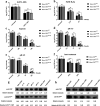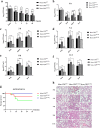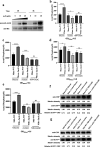Acetylation of Cyclic AMP Receptor Protein by Acetyl Phosphate Modulates Mycobacterial Virulence
- PMID: 36700638
- PMCID: PMC9927398
- DOI: 10.1128/spectrum.04002-22
Acetylation of Cyclic AMP Receptor Protein by Acetyl Phosphate Modulates Mycobacterial Virulence
Abstract
The success of Mycobacterium tuberculosis (Mtb) as a pathogen is partly attributed to its ability to sense and respond to dynamic host microenvironments. The cyclic AMP (cAMP) receptor protein (CRP) is closely related to the pathogenicity of Mtb and plays an important role in this process. However, the molecular mechanisms guiding the autoregulation and downstream target genes of CRP while Mtb responds to its environment are not fully understood. Here, it is demonstrated that the acetylation of conserved lysine 193 (K193) within the C-terminal DNA-binding domain of CRP reduces its DNA-binding ability and inhibits transcriptional activity. The reversible acetylation status of CRP K193 was shown to significantly affect mycobacterial growth phenotype, alter the stress response, and regulate the expression of biologically relevant genes using a CRP K193 site-specific mutation. Notably, the acetylation level of K193 decreases under CRP-activating conditions, including the presence of cAMP, low pH, high temperature, and oxidative stress, suggesting that microenvironmental signals can directly regulate CRP K193 acetylation. Both cell- and murine-based infection assays confirmed that CRP K193 is critical to the regulation of Mtb virulence. Furthermore, the acetylation of CRP K193 was shown to be dependent on the intracellular metabolic intermediate acetyl phosphate (AcP), and deacetylation was mediated by NAD+-dependent deacetylases. These findings indicate that AcP-mediated acetylation of CRP K193 decreases CRP activity and negatively regulates the pathogenicity of Mtb. We believe that the underlying mechanisms of cross talk between transcription, posttranslational modifications, and metabolites are a common regulatory mechanism for pathogenic bacteria. IMPORTANCE Mycobacterium tuberculosis (Mtb) is the causative agent of tuberculosis, and the ability of Mtb to survive harsh host conditions has been the subject of intensive research. As a result, we explored the molecular mechanisms guiding downstream target genes of CRP when Mtb responds to its environment. Our study makes a contribution to the literature because we describe the role of acetylated K193 in regulating its binding affinity to target DNA and influencing the virulence of mycobacteria. We discovered that mycobacteria can regulate their pathogenicity through the reversible acetylation of CRP K193 and that this reversible acetylation is mediated by AcP and a NAD+-dependent deacetylase. The regulation of CRPMtb by posttranslational modifications, at the transcriptional level, and by metabolic intermediates contribute to a better understanding of its role in the survival and pathogenicity of mycobacteria.
Keywords: CRP; Mycobacterium tuberculosis; cAMP; cAMP receptor protein; cyclic AMP; lysine acetylation; virulence.
Conflict of interest statement
The authors declare no conflict of interest.
Figures







Similar articles
-
cAMP is an allosteric modulator of DNA-binding specificity in the cAMP receptor protein from Mycobacterium tuberculosis.J Biol Chem. 2021 Jan-Jun;296:100480. doi: 10.1016/j.jbc.2021.100480. Epub 2021 Feb 26. J Biol Chem. 2021. PMID: 33640453 Free PMC article.
-
Mycobacterium tuberculosis cAMP receptor protein (Rv3676) differs from the Escherichia coli paradigm in its cAMP binding and DNA binding properties and transcription activation properties.J Biol Chem. 2010 Mar 5;285(10):7016-27. doi: 10.1074/jbc.M109.047720. Epub 2009 Dec 22. J Biol Chem. 2010. PMID: 20028978 Free PMC article.
-
Single nucleotide polymorphisms that cause structural changes in the cyclic AMP receptor protein transcriptional regulator of the tuberculosis vaccine strain Mycobacterium bovis BCG alter global gene expression without attenuating growth.Infect Immun. 2008 May;76(5):2227-34. doi: 10.1128/IAI.01410-07. Epub 2008 Mar 10. Infect Immun. 2008. PMID: 18332206 Free PMC article.
-
Regulation of gene expression by protein lysine acetylation in Salmonella.J Microbiol. 2020 Dec;58(12):979-987. doi: 10.1007/s12275-020-0483-8. Epub 2020 Nov 17. J Microbiol. 2020. PMID: 33201432 Review.
-
Bacterial protein acetylation: mechanisms, functions, and methods for study.Front Cell Infect Microbiol. 2024 Jul 4;14:1408947. doi: 10.3389/fcimb.2024.1408947. eCollection 2024. Front Cell Infect Microbiol. 2024. PMID: 39027134 Free PMC article. Review.
Cited by
-
Acetylomics reveals an extensive acetylation diversity within Pseudomonas aeruginosa.Microlife. 2024 Sep 14;5:uqae018. doi: 10.1093/femsml/uqae018. eCollection 2024. Microlife. 2024. PMID: 39464744 Free PMC article.
-
Protein lysine acetylation regulates oral microorganisms.Front Cell Infect Microbiol. 2025 May 15;15:1594947. doi: 10.3389/fcimb.2025.1594947. eCollection 2025. Front Cell Infect Microbiol. 2025. PMID: 40444154 Free PMC article. Review.
-
The role of Mycobacterium tuberculosis acetyltransferase and protein acetylation modifications in tuberculosis.Front Cell Infect Microbiol. 2023 Jul 25;13:1218583. doi: 10.3389/fcimb.2023.1218583. eCollection 2023. Front Cell Infect Microbiol. 2023. PMID: 37560320 Free PMC article. Review.
-
Structural and functional diversity of bacterial cyclic nucleotide perception by CRP proteins.Microlife. 2023 May 1;4:uqad024. doi: 10.1093/femsml/uqad024. eCollection 2023. Microlife. 2023. PMID: 37223727 Free PMC article. Review.
References
-
- Jeremiah C, Petersen E, Nantanda R, Mungai BN, Migliori GB, Amanullah F, Lungu P, Ntoumi F, Kumarasamy N, Maeurer M, Zumla A. 2022. The WHO global tuberculosis 2021 report - not so good news and turning the tide back to end TB. Int J Infect Dis 124:S26–S29. doi:10.1016/j.ijid.2022.03.011. - DOI - PMC - PubMed
-
- Soberon-Chavez G, Alcaraz LD, Morales E, Ponce-Soto GY, Servin-Gonzalez L. 2017. The transcriptional regulators of the CRP family regulate different essential bacterial functions and can be inherited vertically and horizontally. Front Microbiol 8:959. doi:10.3389/fmicb.2017.00959. - DOI - PMC - PubMed
Publication types
MeSH terms
Substances
LinkOut - more resources
Full Text Sources
Research Materials
Miscellaneous

